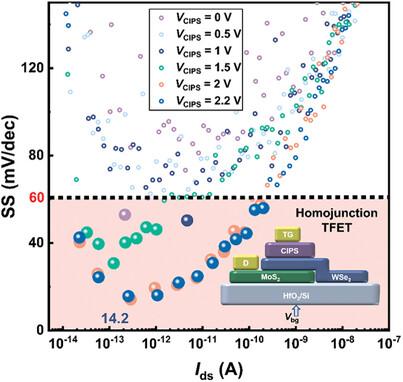当前位置:
X-MOL 学术
›
Adv. Electron. Mater.
›
论文详情
Our official English website, www.x-mol.net, welcomes your
feedback! (Note: you will need to create a separate account there.)
2D Steep‐Slope Tunnel Field‐Effect Transistors Tuned by van der Waals Ferroelectrics
Advanced Electronic Materials ( IF 5.3 ) Pub Date : 2024-10-18 , DOI: 10.1002/aelm.202400463 Xinrui Chen, Tiantian Jiang, Hanbin Wang, Yang Wang, Miao Zhang, Yi Cui, Yong Wang, Nannan Li, Xinchuan Du, Chaoyi Yan, Yuqing Liu, Xianfu Wang
Advanced Electronic Materials ( IF 5.3 ) Pub Date : 2024-10-18 , DOI: 10.1002/aelm.202400463 Xinrui Chen, Tiantian Jiang, Hanbin Wang, Yang Wang, Miao Zhang, Yi Cui, Yong Wang, Nannan Li, Xinchuan Du, Chaoyi Yan, Yuqing Liu, Xianfu Wang

|
sPower consumption has emerged as a central concern in the realm of complementary metal‐oxide‐semiconductor (CMOS) technology. Silicon‐based semiconductor devices have now approached the fundamental thermionic limit of the subthreshold swing (SS), which is 60 mV dec−1 , as defined by the Boltzmann tyranny. Tunnel field‐effect transistors (TFETs) are considered promising low‐power devices due to the band‐to‐band tunneling mechanism, which effectively avoids the thermionic limit. However, TFETs require the establishment of a staggered band alignment and currently lack effective techniques for adjusting the band offset. Here, by harnessing the robust ferroelectric field inherent to 2D CuInP2 S6 (CIPS), a 2D WSe2 /MoS2 heterojunction as well as a WSe2 homojunction TFET controlled by ferroelectric gate are presented. The newly developed TFET achieves an ultra‐low SS of 14.2 mV dec−1 at room temperature, an on/off current ratio exceeding 108 , and a minimal hysteresis window below 10 mV. Additionally, the device demonstrates gate tunable negative differential resistance (NDR) characteristics with a very large peak‐to‐valley current ratio (PVCR) of 10.56 at room temperature. These findings underscore the significant promise of 2D ferroelectric tuning heterojunction and homojunction for future low‐power electronic applications.
中文翻译:

由 van der Waals Ferroelectrics 调谐的 2D 陡坡隧道场效应晶体管
s功耗已成为互补金属氧化物半导体 (CMOS) 技术领域的核心问题。硅基半导体器件现在已经接近亚阈值摆幅 (SS) 的基本热电子极限,即玻尔兹曼暴政定义的 60 mV dec−1。隧道场效应晶体管 (TFET) 被认为是有前途的低功耗器件,因为它具有带间隧穿机制,有效地避免了热电子极限。然而,TFET 需要建立交错的频带对齐,并且目前缺乏调整频带偏移的有效技术。在这里,通过利用 2D CuInP2S6 (CIPS) 固有的稳健铁电场,提出了由铁电栅控制的 2D WSe2/MoS2 异质结以及 WSe2 同质结 TFET。新开发的 TFET 在室温下实现了 14.2 mV dec-1 的超低 SS,开/关电流比超过 108,并且最小磁滞窗口低于 10 mV。此外,该器件还表现出栅极可调负差分电阻 (NDR) 特性,在室温下具有 10.56 的非常大的峰谷电流比 (PVCR)。这些发现强调了 2D 铁电调谐异质结和同结在未来低功耗电子应用中的重要前景。
更新日期:2024-10-18
中文翻译:

由 van der Waals Ferroelectrics 调谐的 2D 陡坡隧道场效应晶体管
s功耗已成为互补金属氧化物半导体 (CMOS) 技术领域的核心问题。硅基半导体器件现在已经接近亚阈值摆幅 (SS) 的基本热电子极限,即玻尔兹曼暴政定义的 60 mV dec−1。隧道场效应晶体管 (TFET) 被认为是有前途的低功耗器件,因为它具有带间隧穿机制,有效地避免了热电子极限。然而,TFET 需要建立交错的频带对齐,并且目前缺乏调整频带偏移的有效技术。在这里,通过利用 2D CuInP2S6 (CIPS) 固有的稳健铁电场,提出了由铁电栅控制的 2D WSe2/MoS2 异质结以及 WSe2 同质结 TFET。新开发的 TFET 在室温下实现了 14.2 mV dec-1 的超低 SS,开/关电流比超过 108,并且最小磁滞窗口低于 10 mV。此外,该器件还表现出栅极可调负差分电阻 (NDR) 特性,在室温下具有 10.56 的非常大的峰谷电流比 (PVCR)。这些发现强调了 2D 铁电调谐异质结和同结在未来低功耗电子应用中的重要前景。


















































 京公网安备 11010802027423号
京公网安备 11010802027423号